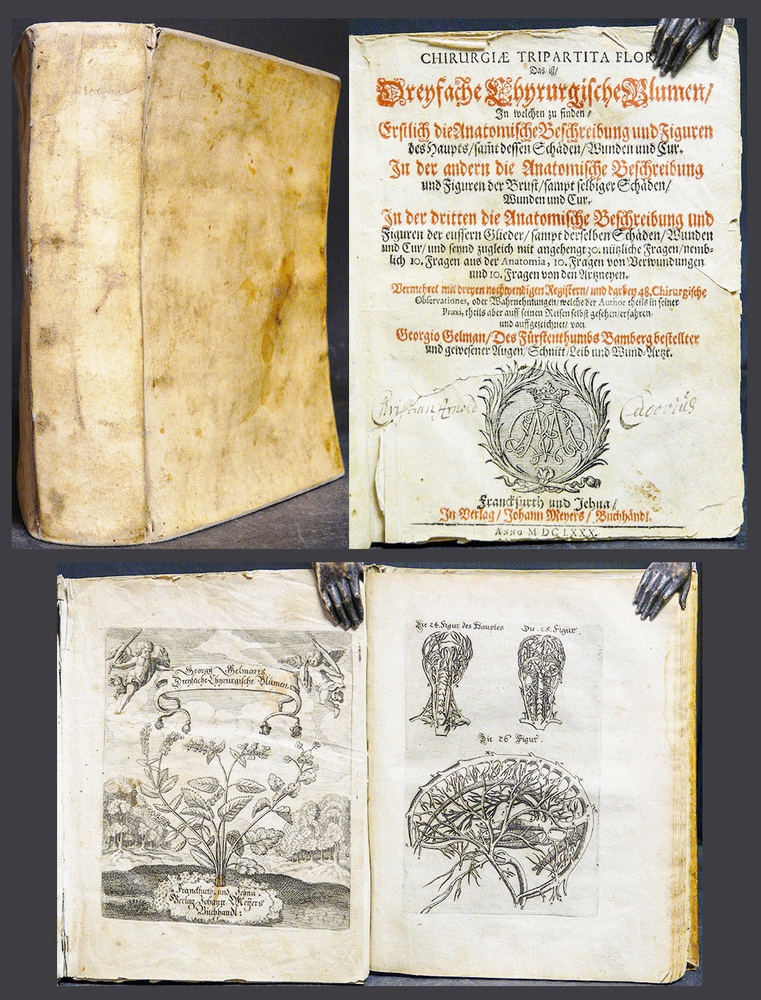Gelman, Gregorius (d. 1672): Chirurgiae tripartita flora, das ist dreyfache chyrurgisches Blumen, in welchen zu finden, erstlich die anatomische Beschreibung und Figuren des Haupts, sammt dessen Schäden, Wunden und Cur (1680)
€950,00
Georgius Gelman (- d. 1672)
CHIRURGIAE TRIPARTITA FLORA D. IST, DREYFACHE CHYRURG. BLUMEN, IN WELCHEN ZU FINDEN, ERSTL. D. ANATOM. BESCHREIBUNG U. FIGUREN D. HAUPTS, SAMMT DESSEN SCHÄDEN, WUNDEN U. CUR ; IN D. ANDERN D. ANATOM. BESCHREIBUNG U. FIGUREN D. BRUST, SAMPT SELBIGER SCHÄDEN, WUNDEN U. CUR ; IN D. DRITTEN D. ANATOM. BESCHREIBUNG U. FIGUREN D. EUSSERN GLIEDER, SAMPT DERSELBEN SCHÄDEN, WUNDEN U. CUR ; U. SEYND ZUGL. MIT ANGEHENGT NÜTZL. FRAGEN, NEMBL. 10 FRAGEN AUS D. ANATOMIA, 10 FRAGEN VON VERWUNDUNGEN U. 10 FRAGEN VON D. ARTZNEYEN.
Franckfurth und Jehna, In Verlag Johann Meyers, M.DC.LXXX, (1680). Second edition.
Description : [small 4to] – pp. [8], 488, [38] + 36 copper engrav. plates and frontispiece
Second edition (1680) a reprint of the 1652 edition published under title: Tripartita; das ist, Dreyfache chyrurgische Blumen by the German physician Georgius Gelman, the work is organized in three sections. The first part describes in details the anatomy of the human head, many sorts of possible injuries, problems and diseases which might occur as well as the way to cure pathologies and wounds related to the head. Among possible remedies the author describes the procedure and way to use the surgical instruments to perform cranium trepanation (pp.263 and following) in which a hole is drilled into the skull, thus exposing the dura mater in order to supposedly treat intracranial problems, it is worth mentioning that the procedure was quite common at the times even though it often resulted in the death of the patient mostly due to infections. In the modern era it is used only to treat epidural and subdural hematomas, and for surgical access for certain other neurosurgical procedures, such as intracranial pressure monitoring. The second and the third parts treat respectively of the anatomy, injuries and diseases of internal organs and bones located in the torso and in the upper and lower limbs. The book is enriched completed by a wonderful set of copper engraved tables portraying the different part of the human body, including bones, muscle, veins, nervous and lymphatic system, brain and in the end a whole set of antique medical and surgical instruments.
An intriguing XVII century surgery book in contemporary full parchment binding, engraved allegoric frontispiece, double coloured title page in red and black, woodcut head and tail pieces in the text and some decorated initials, nice gothic typeface, a few marginal tears in some pages due to use as this book was very probably a practical reference text for physicians, some tears also affect the lower inner side of title page close to the printer’s device with frayed external margins, some tears also to the engraved tables in the end, usual foxing and moderate spotting due to age, last leaf of the REGISTER almost flying freely due to a vertical tear, for the rest good. A fascinating antique book of medicine.
Cfr.: AA.VV. Bericht über das Wirken und den Stand des historischen Vereins zu Bamberg, Bamberg 1845, p. 43, n.363. VD17, Das Verzeichnis der im deutschen Sprachraum erschienenen Drucke des 17 Jahrhunderts, Bibliography of German Imprints of the XVII Century, ref. 39:146142V ; COPAC UK Wellcome Library of Medicine, ref. EPB / B24287/B.




